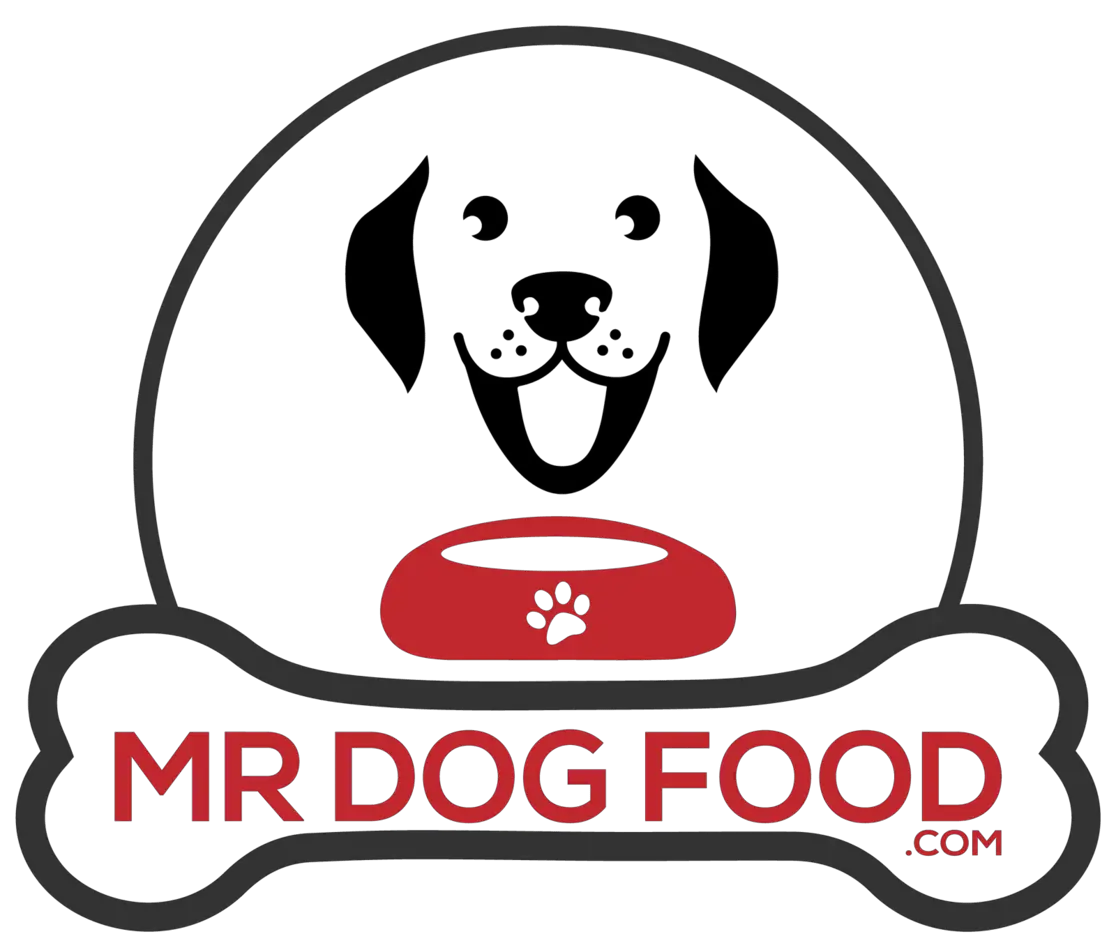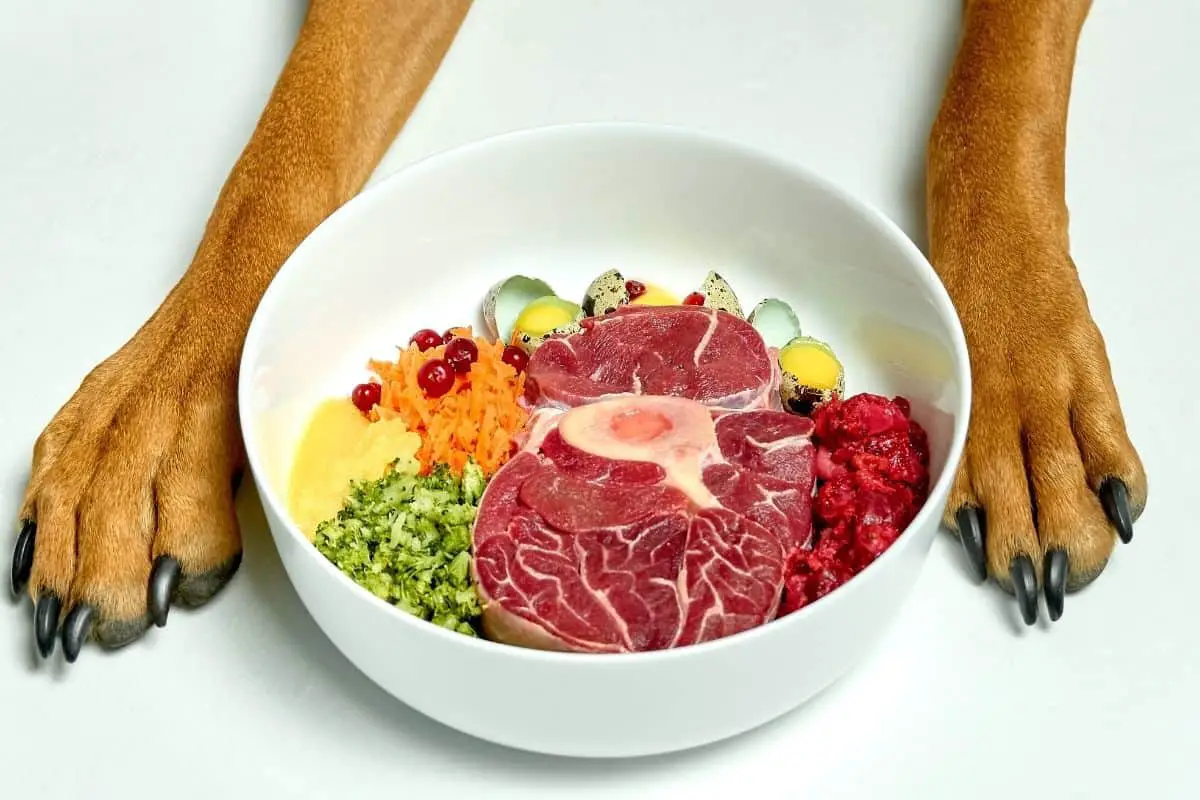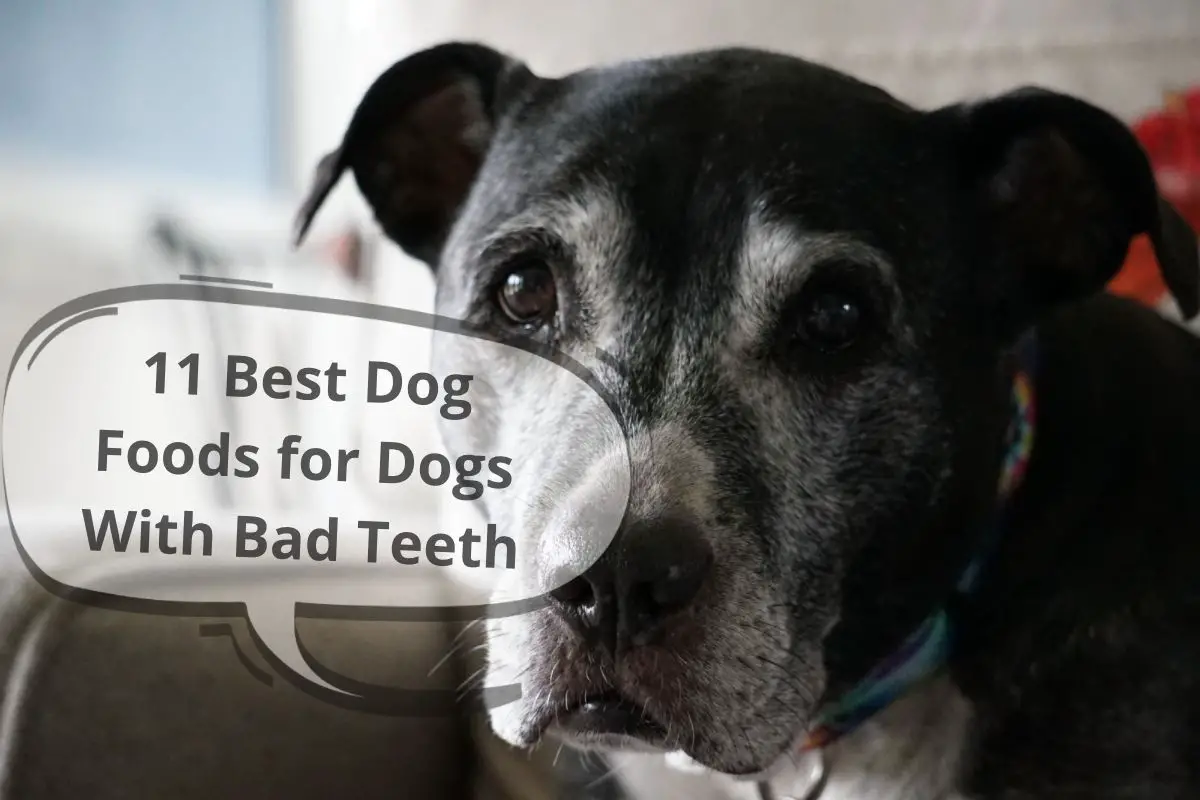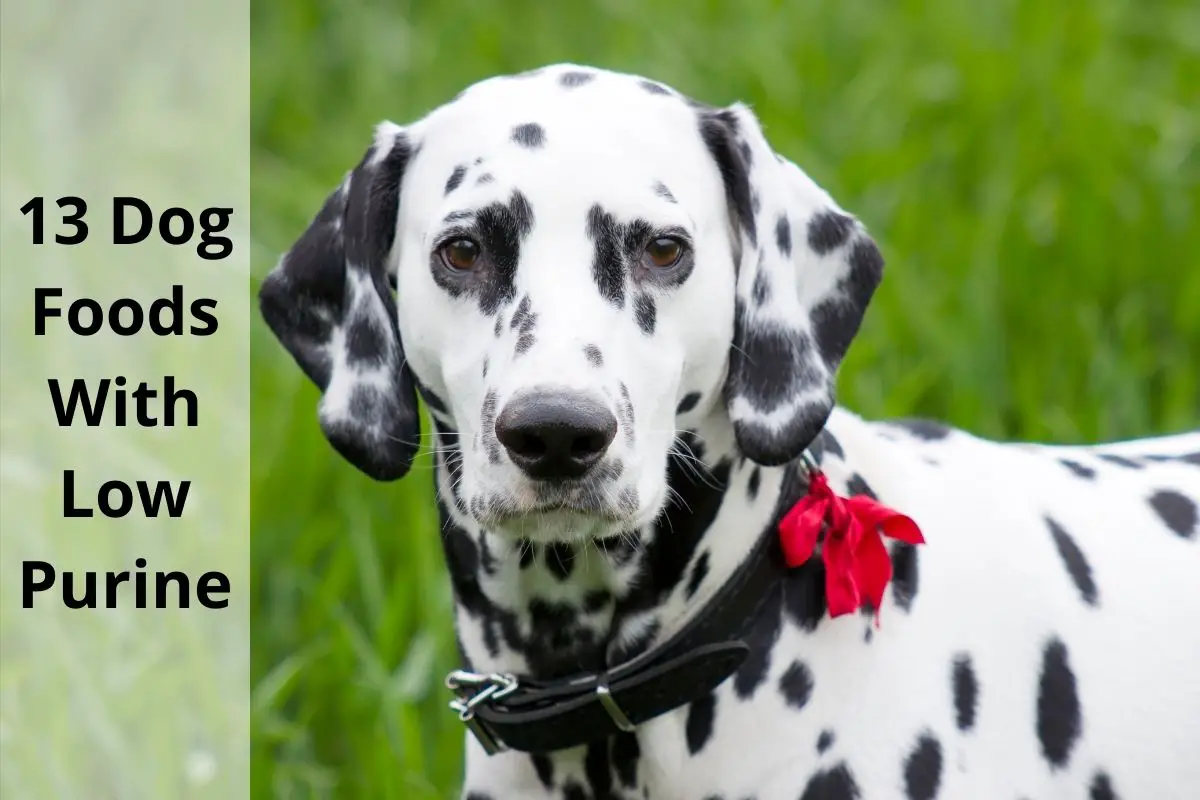This post contains affiliate links.
Your dog’s dietary and nutritional needs, and subsequently the meals he eats under a raw food diet, require careful planning and research. Knowing the right ingredients and their nutritional values will help you figure out how to plan and balance your dog’s raw diet.
Here are a few essential ways to balance a raw diet as a dog owner:
- Adjust ingredient ratios based on your dog’s dietary needs.
- Choose a raw diet that offers the best nutritional benefits.
- Add and alternate high-protein meats.
- Incorporate size-appropriate bones to boost calcium intake.
- Include vitamin-rich organs.
- Mix in fresh fruits and vegetables.
- Test your dog for allergies before adding dairy products.
- Avoid raw fish and opt for cooked, deboned fish.
- Divide your dog’s daily intake into two feeding portions.
Let’s take a look at how you can find the right balance and combination of raw ingredients, how they contribute to your dog’s diet in terms of nutrition, and how much of them your pet will need.
Adjust Ingredient Ratios Based on Your Dog’s Dietary Needs
By a general rule of thumb, a balanced diet for dogs—raw or otherwise—should contain five essential elements:
- Protein
- Carbohydrates
- Fats
- Vitamins and minerals
- Fiber
As the primary element, protein should make up around 20-25% of an adult dog’s diet. Your dog will require 1 gram (0.03 oz) of protein for every pound of his body weight.
Carbohydrates should make up another 20%, but not empty carbs from sugary treats and snacks. When it comes to his fat intake, consider no more than 5.5% to 6% of soluble, healthy fats.
An adult dog will also need copious amounts of fiber and water in his diet, typically from fruits and vegetables, for healthy digestion. Then, apart from that, there are vitamins and minerals which you can get organically from a balanced diet or in the form of supplements.
This rule should ideally transfer to your dog’s raw food diet as well. A balanced raw diet includes the correct percentages of protein, fat, carbs, vitamins and minerals, and fiber. With that in mind, there are different raw diets to consider and various ways to balance a dog’s diet based on the diets’ guidelines.
Choose a Raw Diet That Offers the Best Nutritional Benefits
After calculating your dog’s unique dietary requirements, you can then select a raw diet formula that accommodates those specific needs. There are three popular raw food diets that many dog owners choose from when balancing their dog’s daily intake.
BARF Diet
As unfortunate as the name is, the BARF diet—Biologically Appropriate Raw Food, or Bone and Raw Food as some refer to it—is one of the most popular types of raw food diets to feed your dog. It contains a combination of fresh, uncooked meat, bones, fruits, vegetables, dairy, and sometimes, herbs, seeds, eggs, and wholegrains.
Unlike a purely raw diet—one that includes only what dogs used to eat when living entirely in the wild—the BARF diet includes the above elements as well. The diet can also include mineral and vitamin supplements to make up for some of the nutrients your dog won’t get from a raw diet.
Ratio of Meat-Bones-Organs-Vegetables in BARF Diet
Here’s an idea of what the BARF diet recommends for a balanced diet per meal:
- 70% of one meal should be lean meat
- 10% should be bone
- 5% of liver
- Another 5% of organs like kidney, heart, and pancreas
- The other 10% will include fruits (2%), vegetables (7%), and seeds (1%)
The Prey Model Diet
The Prey Model Diet is all about going back to the basics and imitating what wild animals and dogs ate in the wild. Your dog would eat only what they’d consider ‘prey’ in the wild: chicken, ducks, game fowl, and rabbits.
Ratio of Meat-Bones-Organs-Vegetables in the PMD
Under the Prey Model Diet guidelines, one square meal should consist of the following ratios of meat, bones, and organs:
- 80% muscle meat
- 10% raw bones
- 5% liver
- 5% organs like kidney, heart, and pancreas
RMB Diet: Raw Meaty Bones Diet
Unlike the BARF diet, the RMB Diet consists of uncooked animal bones, muscles, and organs, either homemade or commercially prepared. However, it doesn’t allow room for fruits or vegetables, which begs the question of whether such a diet can truly be balanced without a wholesome, rounded, and inclusive list of ingredients.
That being said, a meat-and-bone-based diet does wonderful things when it comes to building a robust skeletal system—bones, joints, muscles, and the works—as well as healthy teeth, gums, and jowls.
Ratio of Meat-Bones-Organs Under RMB Diet
- 70% raw, meaty bones
- Balance 30% can include table scraps, offal, organs, or more meaty bones
Although the BARF diet is perhaps the most popular of the three, the other two are also viable options to pick from. Regardless of which raw diet formula you select, all three require higher ratios of healthy proteins above the other ingredients, so it’s vital to choose those proteins wisely.
Add and Alternate High-Protein Meats
The best way to balance out a diet to meet your dog’s nutritional needs and their taste preferences is to keep alternating between the bones and meats you feed him. Different meats provide various nutrients, which means that you need to keep rotating them to make sure your dog benefits from a raw diet.
Chicken, turkey, beef, and pork are the most popular meats to feed dogs on a raw food diet. Shanks of mutton, while also allowed, aren’t often used because of how hard they are to digest. Lean meat cuts and muscled meat, usually still on the bone, can also be added to the bowl.
Chicken for Lean Protein
You think lean meat, and you pick chicken. This is because it’s one of the most common white meats used in the raw food diet plan, seeing as how rich a source of protein it is and because it happens to be relatively less calorific.
Lean meat from chicken helps build muscle mass and provides your dog with amino acids. Amino acids, in turn, help synthesize protein in the body, provide energy, and keep the immune system strong.
Considering that it’s an affordable choice of protein, you can easily incorporate chicken into your dog’s meal. You can include shredded chicken, wings, beaks, breasts, thighs, and even necks.
Turkey for More Nutrients
Turkey meat is another popular ingredient in most dog foods and is a safe option to feed your dog as a part of their raw diet. It contains nutrients like:
- Phosphorus: which helps to improve kidney functions and prevent kidney-related diseases
- Riboflavin: which helps facilitate enzyme functions and boost your pet’s metabolism
Beef for Amino Acids
Another choice of protein is beef, which is considered particularly tasty by dogs. You can easily use ground beef, which doesn’t require any cutting. Just measure the portions or weigh them, and then scoop it into the meal.
Beef will provide a good dose of omega-3, which helps your dog’s skin and coat be healthy and shiny. It also contains copious amounts of iron and, like chicken, is a wonderful source of amino acids.
A meal with beef as the meat of choice is often used to feed dogs who require high energy levels daily: herding dogs, dogs undergoing muscle building or training exercises to perform or join the armed forces, and the likes.
Pork for Fatty Acids
Pork meat has considerable fat content, and when feeding your dog pork, choosing the proper cut and the correct quantity is essential. As opposed to pork loin, pork tenderloin is a better cut, seeing as how it’s lean meat with hardly any fat.
Pork contains the following vitamins and minerals: vitamin B1, B3, B6, B12, and an excellent source of fat-soluble vitamin D. Pork also contains omega-3 fatty acids and omega-6 acids. This is why it’s used primarily in both the Prey Model and RMB, which don’t allow for vegetables or fruits.
Lamb for Essential Vitamins
Lamb is one of the fattier meats, and while that’s something to consider, it also happens to be rich in B3 and B12 vitamins and zinc and selenium. B12 is essential for good digestive health in dogs, while B3 vitamin—niacinamide—is needed for proper blood circulation and overall health and longevity.
Mutton To Enhance Skin Health
Mutton liver is perhaps more popular than mutton meat, as the latter can be a relatively tougher meat for your dog to digest. However, it’s been known to promote skin health in dogs, so if you do add mutton, be sure your dog can safely digest it and has plenty of drinking water nearby.
Venison as an Allergy Alternative Meat
Venison provides a good dose of iron, zinc, and phosphorus to a raw diet. It’s particularly easy to digest, and additionally, it’s an excellent alternative to dogs that are allergic to other meats, like pork, beef, or even chicken.
Additionally, Venison is a popular option under the RMB Diet plan and the Prey Model Diet, seeing as deer are considered a natural prey, and their meat, especially the ribs and flanks, is highly preferred.
Incorporate Size-Appropriate Bones To Boost Calcium Intake
Bones are chock-full of minerals. They’re rich in calcium, and they have phosphorus, magnesium, and zinc. A well-balanced dose of these minerals will, in turn, help your dog build their bones, along with their muscles and dental health.
Of course, bones in the diet also help keep a bored dog occupied, adding mental stimulation to the list of benefits.
A solely meat-based diet should also include an adequate supply of bones to provide your dog with these vitamins and minerals. You can grind bones into a smooth powder and scoop some onto their bowl. This will reduce the chance of them choking on a bone fragment.
Keep in mind: Choose bones that are size-appropriate for your dog. For example, chicken bones for big dogs will hardly be filling, and a massive piece of beef ribs will be overwhelming to smaller breeds. Also, if you’re grinding the bones, make sure the powder is fine and smooth, without any chunks or bits that your dog might choke on.
Bone can be derived from chickens or other poultry, lamb, pork, venison, beef, and even oxen tail and hooves.
Grind Soft Bones To Avoid Choking Hazards
Soft bones are safer for dogs when ground into a fine powder, but don’t worry; grinding them won’t reduce their nutritional value. They’re rich in calcium, and the bone marrow offers a salty and savory taste for your dog.
The following soft bones have the perfect crunch to meat ratio:
- Feet
- Backs
- Necks
- Wingtips
Hard Bones Are Safe Whole
Unlike soft bones, hard bones don’t need to be ground into a fine powder because they’re safe to feed whole. Hard bones aren’t easy for dogs to bite into or choke on, but they’re great for natural teeth cleaning and are equally rich in calcium.
The following hard bones are safe to feed your dog whole:
- Ribs: Ribs can be meaty as well as high in bone content.
- Frames and carcass: They’re high in bone content, and thus, high in calcium.
- Tails: Pork, lamb, and goat tails are meaty and suitable for most dogs. For smaller dogs, you might need to cut them down to size—the tails, that is.
Include Vitamin-Rich Organs
In conjunction with lean proteins and bones, organs are rich in essential vitamins and offer various nutritional benefits to dogs. Organ meat makes up another 10% of a balanced raw diet, and liver, in particular, is 5% of that 10%, but the latter half comes from kidneys, stomach, heart, and pancreas.
Liver for Healthy Iron Levels
Ideally, around 5% of a balanced meal should contain liver because it has a great reserve of vitamin A, iron, zinc, B vitamins, and most importantly, it helps to cleanse the blood. Liver is also used to feed dogs that are recovering from an injury or illness.
While your dog gets their protein and carbohydrates from their muscle meat, a portion of liver contains almost six times the amount of iron, which will help regulate their core temperature and increase strength and endurance.
The best kind of liver comes from beef, goat, chicken, lamb, turkey, and duck.
Kidneys, Lungs, and Pancreas for More Vitamins
Kidneys, specifically chicken kidneys, are responsible for a large chunk of your dog’s vitamin intake, like vitamins D, B, K, A, and E, as well as iron.
Lungs, pancreas, and stomachs are less nutritionally dense but do make great alternatives to any food your dog is allergic to, should you require it.
Mix in Fresh Fruits and Vegetables
You should also stretch a balanced raw food diet to include vegetables, fruits, nuts. Fresh produce provides their diet with a wide variety of necessary vitamins and minerals and adds another protein source.
Vegetables for Potassium and Hydration
Fresh vegetables can provide your dog with much-needed potassium, fiber, and hydration. Since vegetables are low in calories and high in nutrients, they’re recommended additives for your dog’s raw diet. Most vegetables are also low in sugar, so they’re better for your dog to consume regularly.
Here are some tasty vegetables your dog can try:
- Spinach: This is a powerhouse veggie packed with potassium, magnesium, and vitamins B6, B9, and E, in addition to significant amounts of vitamin C and K, folic acid, iron, and calcium. Other leafy vegetables you can include in your dog’s diet are kale, celery leaves, and lettuce.
- Carrots: They’re rich in vitamin A, K, potassium, and vitamin B6.
- Celery and cucumber: They have substantial water content to maintain hydration.
- Broccoli and green beans: Broccoli supplies vitamin K to your dog and will promote stronger and healthier bones. On the other hand, green beans are a source of fiber and contain vitamins K, C, and A. They’re low in calories, which makes them the perfect addition to your dog’s meal if they’re on a diet.
- Yams, pumpkins, and sweet potatoes: Yams, sweet potatoes, and even pumpkins are rich in vitamins, minerals, and fiber. You can easily puree these vegetables and scoop a serving into your dog’s bowl. Start with no more than an ounce or two (28.35 to 56.7 grams) per serving to check if your dog can safely digest them.
Fruits That Are High in Antioxidants
Apples, pears, and berries are the safest fruits. Avoid fruits with pits, like cherries, as these could pose a choking hazard to your dog. Berries like strawberries, blackberries, and blueberries are rich in antioxidants, can boost your dog’s immune system, and are safe for consumption. Don’t feed them citrus fruits like oranges or lemons.
Test Your Dog for Allergies Before Adding Dairy Products
Some dogs are sensitive to dairy products and aren’t able to digest them properly. Before adding them to your dog’s diet, you should test their tolerance first to ensure dairy products are safe for consumption.
If you do decide to add dairy products, choose yogurt, cheese, and milk, but only unpasteurized and unhomogenized, as they’re not ‘processed,’ and thus, remain raw.
If your dog is allergic to dairy products, you can grind eggshells and incorporate them into their raw diet as an alternative source of calcium. Refrain from feeding your dog raw eggs because they pose a risk of salmonella.
Avoid Raw Fish and Opt for Cleaned, Deboned Fish
You’re probably asking yourself if you can give them raw fish. Dogs do catch fish and eat them in the wild, which means they do belong in the Prey Model Diet, RMB Diet, and the BARF Diet.
However, while they’re a rich source of nutrients—and dogs really do love fish meat—raw, uncooked fish can often have roundworms or tapeworms. So make sure you feed them good quality fish that’s been cleaned and deboned.
That being said, fish is often used as an alternative meat choice for dogs allergic to other meats like chicken or beef.
Divide Your Dog’s Daily Intake Into Two Feeding Portions
Ideally, you should split your dog’s daily quota into two meals and feed them twice a day. Their meals should be no more than 3% of their body weight. However, if your dog has an active lifestyle, they might need more. If they have a tendency to be lazy, then they’ll probably need less.
For puppies, you’ll need to feed them at least 5% of their body weight, preferably over three meals, to give their body time to digest the food.
However, depending on their nutrition intake, the quantity you feed them will vary once again, as will the kind of raw food you’ll need.
Conclusion
Balancing your dog’s raw diet will require planning and proportioning your dog’s meals with the right raw foods. You’ll need to incorporate wholesome ingredients that are tailored to your dog’s nutritional requirements and daily intake needs and rotate the lean proteins to make meals exciting, include dog-safe bones, and add some fresh organs and produce for more vitamins and minerals.
Sources
- Fetch by Web MD: Raw Dog Food: Dietary Concerns, Benefits, and Risks
- Homes Alive: Homemade Raw Dog Food: A Complete and Balanced Raw Diet for Your Dog
- AKC: Fresh vs. Raw vs. Kibble: What Should You Feed Your Dog?
- Fetch by Web MD: Caring for a Dog with Food Allergies
- Darwin’s Pet: BARF Diet for Dogs: A Comprehensive Guide
- Pet MD: What You Need to Know About Raw Food Diets for Dogs
- Dog Gone Real: How Much Raw Food Should I Feed My Dog? – 3 Ways to Calculate
- Chances Little Website: Beginner’s Guide to Prey Model Raw
- Raw Meaty Bones: Diet guide for domestic dogs and cats
- Juicing and Raw Foods: The Pros & Cons of a Raw Food Diet
- Research Gate: Risks and Benefits of Raw Meat-Based Diets For Dogs
- Pet MD: Chicken For Dogs
- American Kennel Club: Can Dogs Eat Chicken?
- WikiVet: Riboflavin For Dogs
- American Kennel Club: Can Dogs Eat Turkey?
- Wikivet: Vitamin B3 Niacin For Dogs
Mrdogfood.com is a participant in the Amazon Services LLC Associates Program, an affiliate advertising program designed to provide a means for sites to earn advertising fees by advertising and linking to Amazon.com. We also participate in other affiliate programs which compensate us for referring traffic.




